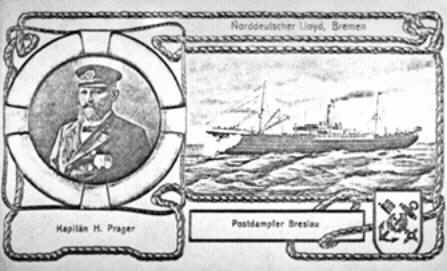Karl and Anna Petrat's Immigration From Kovno, Russia by Land
to Bremen, Germany then on to |
|||||||||||||||||||||
|
|||||||||||||||||||||
| Once I had the
basics, her name, year built, size, etc., I continued my research and found all the
information you see here. If you happen to be researching your own family history, in
search of passenger ships, there are several resource web sites listed on this page. To summarize for you, the SS Breslau began her life as a German passenger steamship and ended her life as a US Army Transport. She fell into US hands at the onset of US involvement in WWI while in the port of New Orleans. There were many changes in her use, including changes to her name; Breslau - Bridgeport - Larkspur and then back to Bridgeport in the end. While you read and think about travelling aboard the SS Breslau, remember, at best the journey from Europe to the US was nearly two weeks. The conditions for most were not good. It is also important to note that Karl and Anna were traveling with 6 children, one of them a baby of 3 months! This was not a romantic cruise by any stretch. Rather it was a journey with hope for a better life in a new land. To them, the unpleasantness of the journey was well worth the positive changes they hoped for in their lives. |
|||||||||||||||||||||
|
|||||||||||||||||||||
| SS
BRESLAU The steamship BRESLAU, (ship #439), was a 7524 ton vessel built by Bremer Vulkan at Vegesack for Norddeutscher Lloyd [North German Lloyd]. Her dimensions were length 429.3ft x beam 54.3ft, one funnel, two masts, twin screw, quadruple expansion engines (3600 horsepower), and a speed of 13 knots. There was accommodation for 60-2nd class and 1,660-3rd class, steerage passengers, crew of from 94-120. The Breslau was built as an emigrant carrier for the Baltimore-Gulf route. Launched on 8-14-1901, she left Bremen on her maiden voyage to New York on 11-23-1901. On 4-3-1902, she made her first voyage on the Bremen - Baltimore service and on 9-10-1903, she went on to the Bremen - Baltimore - Galveston run. On 3-24-1910, transferred to Bremen - Philadelphia run and on 5-16-1914, to the Bremen - Boston - New Orleans service. She made her last trip for this company when she left Bremen on 7-8-1914, and arrived at NY on 7-24-1914, via Emden and Boston. She then continued to New Orleans where she stayed until 1917 when she was seized by the Collector of the Port of New Orleans on American entry into World War I; turned over to the Shipping Board; transferred to the Navy at New Orleans and renamed Bridgeport on June 9, 1917; commissioned on August 25, 1917, Lieutenant Commander A. B. Randall, USNR, in command. Since the German crew had disabled the vessel she had to undergo extensive repairs at New Orleans and Boston prior to joining the fleet. Originally scheduled to be converted to a repair ship she was designated AR-2 but was completed as a destroyer tender and re designated AD-10. On March 1, 1918 Bridgeport was assigned to the Destroyer Force, Atlantic Fleet. After convoying small craft to the Azores, she arrived at Brest, France, August 5, 1918 and remained there as base repair and supply ship until October 15, 1919. After the war she operated with the fleet as a repair and supply ship; aided in the rescue of S-5 during September 1920; and served as flagship, Destroyer Squadrons 3 and 8, Atlantic Fleet. Early in 1923 Bridgeport was assigned as tender, Destroyer Squadrons, Scouting Fleet and cruised off the Atlantic coast and in the Caribbean. She arrived at Boston Navy Yard on June 30, 1924; went out of commission in reserve on November 3, 1924. In 1943 she was converted to the US Army Hospital ship Larkspur, (read more about US Army Hospital ships later), and in 1946 became the US Army Transport returning to her former name of BRIDGEPORT. Sold to H. H. Buncher, Pittsburgh, for scrapping. 1948, scrapped at Mobile, Alabama. From the web sites of:
Reference credits:
ABOUT THE SHIP COMPANY THAT OWNED THE BRESLAU
The North German Lloyd Line (NGL) was founded in 1857 by the amalgamation of four smaller companies. They commenced operations between Bremen and London with six 500 ton steamers. Transatlantic voyages to New York started in June, 1858; Baltimore in March, 1868; and in 1869 regular sailing commenced to New Orleans. A service to Central America was instituted in 1871, but was withdrawn in 1874. Voyages from Bremen to Brazil and the River Plate started in 1876 and Genoa to Brazil and River Plate in 1878, the latter service only lasting for three years. By 1866 NGL was making weekly runs to New York and in 1874 averaged 11 days and 13 hours on its sailings. From 1882 onwards, the New Orleans service was extended to Galveston, but the whole route was abandoned in 1886. Two new routes from Bremen to the Far East and Bremen to Australia were opened in 1886, both via Suez. Italy to New York sailings commenced in October, 1891 and in 1897, the Bremen - UK service was sold to Argo Steamship Company together with seven ships. Occasional sailings between Bremen and Galveston resumed in 1898 and became regular in 1899. A fortnightly service was started in 1893 by what they called their Roland Line. The Roland Line sailed from Bremen to New York with steerage passengers and cargo. By December of 1893 the line owned 80 vessels. In 1904 a new service from Marseilles to Naples and Alexandria started and in 1909 a joint summer service between Bremen and Hamburg to Quebec and Montreal was instituted with Hamburg America, Red Star and Holland America Lines. Bremen - Galveston ships commenced calls at Philadelphia in March, 1910 and a new service started in 1913 to Boston and New Orleans. At the outbreak of WWI, many NGL ships took refuge in US ports, and these were seized by American authorities in 1917. After the Armistice, the company lost every worthwhile ocean going steamer as war reparations, and in 1920 chartered ships from the US Shipping Board to resume services. They gradually rebuilt their fleet and in 1925 took over the Hamburg-Bremen Africa Line, the Dampschiff Reederei Horn and the Roland Line. In 1928 Quebec and Montreal services were resumed. During World War II, NGL again lost almost their entire fleet and again restarted with chartered ships. In 1970 the company amalgamated with Hamburg America Line to become HAPAG-Lloyd. From The Ships List Web Site - www.theshipslist.com ELLIS ISLAND SHIP RECORDS Built by Bremer Vulkan Shipbuilders, Vegesack, Germany, 1901. 7,524 gross tons; 429 (bp) feet long; 54 feet wide. Steam quadruple expansion engines, twin screw. Service speed 13 knots. 1,720 passengers (60 second class, 1,660 third class). Built for North German Lloyd, German flag, in 1901 and named Breslau. Bremerhaven-New York and Bremerhaven-Baltimore service. Interned in the United States 1914-17. Seized by US Government, in 1917 and renamed USS Bridgeport. Transport service. Transferred to United States Navy, American flag, in 1943 and renamed USS Larkspur. Hospital ship service. Renamed USS Bridgeport in 1946. Scrapped in 1948. THE SS BRESLAU – 1901
ARMY TRANSPORT SERVICE HOSPITAL SHIPS During World War II the Army Transport Service operated a total of 24 hospital ships which were manned by civilian crews, employees of the Army Transport Service. The medical staff were Army personnel. The hospital ships were operated under the provisions of the Hague Convention X of 1907, which specified identifying markings. These proved inadequate, so large illuminated red crosses on deck were added for aerial visibility at night. Hospital ships were allowed to carry medical supplies as cargo for the battlefield. Most of the hospital ships were former passenger liners/troopships which were disarmed, repainted, and rearranged for hospital use. 6 Liberty ships were converted for hospital use. Former names are listed in parentheses. This list of Hospital Ships is from Roland W. Charles, Troopships of World War II, 1947. If you would like photocopy of the information about a ship, please send a donation ($US) to support our research and Web Site to USMSV, POB 2361, Berkeley, CA 94702 Acadia Hospital Ships of World War II: An Illustrated Reference, Emory A. Massman, McFarland & Company, Inc. Box 611, Jefferson, North Carolina 28640 1-800-253-2187 From the web site of The U.S. Maritime Service Veterans - www.usmm.org - 6/5/00 |
|||||||||||||||||||||
HOSPITAL SHIP HISTORY BRESLAU - BRIDGEPORT - LARKSPUR
SS BRESLAU - BRIDGEPORT - LARKSPUR Shown during one of her best times as US Army Hospital Ship Larkspur
Photograph and hospital ship history thanks to: Ray Seiple |
|||||||||||||||||||||
| BRESLAU 1882 There was another "Breslau" ship built in 1882. It does not appear to have made the transatlantic voyages taken by immigrants though. I don’t believe this is the ship our ancestors traveled on to come to the U.S. but I’m including the information to distinguish the two ships for those researching this in the future - Patricia Petrat Leith, Hull & Hamburg Steam Packet Company The Leith, Hull & Hamburg Steam Packet Company ran a service between Leith / Hull-Hamburg and Leith-Copenhagen / Christiansand. Fleet
BRESLAU 1882 The steamship BRESLAU, (Ship #439), was a 1,366 gross ton ship belonging to the Leith, Hull & Hamburg Steam Packet Co. Her details were - length 254.5ft, beam 33.2ft, one funnel, three masts, single screw and a speed of 12 knots. There was accommodation for 56-1st class forward of the bridge, 170-2nd class in the poop and a number of steerage passengers in the 'tween deck. Built by Robert Steele & Co, Greenock, she was launched on 22nd Dec.1882 and her sister ship COBLENZ was launched three months later. The two ships maintained a regular service, departing from Leith for Hamburg on Wednesdays and Saturdays. World War I forced her to trade elsewhere and on 14th Jan.1916 she hit a mine six miles off Boulogne and was beached, but later salvaged. In 1917 she was involved in a gun battle with a U-Boat in the Atlantic, but escaped. After the war, she was transferred to the Leith-Copenhagen service until 1928 when she returned to the Hamburg trade. She was scrapped at Queensferry in 1932. [A Century of North Sea Passenger Steamers by Ambrose Greenway, published by Ian Allan Ltd, ISBN 0-7110-1338-1] |
|||||||||||||||||||||





